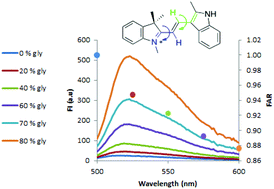当前位置:
X-MOL 学术
›
Photochem. Photobiol. Sci.
›
论文详情
Our official English website, www.x-mol.net, welcomes your feedback! (Note: you will need to create a separate account there.)
The cationic dye basic orange 21 (BO21) as a potential fluorescent sensor†
Photochemical & Photobiological Sciences ( IF 3.1 ) Pub Date : 2018-09-17 00:00:00 , DOI: 10.1039/c7pp00455a Zehavit Eizig Bar-On 1, 2, 3, 4, 5 , Mark A. Iron 6, 7, 8, 9, 10 , Harvey L. Kasdan 11, 12, 13 , Dan Amir 3, 5, 14, 15 , Elena Afrimzon 1, 2, 3, 4, 5 , Naomi Zurgil 1, 2, 3, 4, 5 , Sergei Moshkov 1, 2, 3, 4, 5 , Mordechai Deutsch 1, 2, 3, 4, 5
Photochemical & Photobiological Sciences ( IF 3.1 ) Pub Date : 2018-09-17 00:00:00 , DOI: 10.1039/c7pp00455a Zehavit Eizig Bar-On 1, 2, 3, 4, 5 , Mark A. Iron 6, 7, 8, 9, 10 , Harvey L. Kasdan 11, 12, 13 , Dan Amir 3, 5, 14, 15 , Elena Afrimzon 1, 2, 3, 4, 5 , Naomi Zurgil 1, 2, 3, 4, 5 , Sergei Moshkov 1, 2, 3, 4, 5 , Mordechai Deutsch 1, 2, 3, 4, 5
Affiliation

|
The present study investigates the fluorescence properties of BO21 and their dependence on various intracellular conditions. The results obtained with cell-free solutions indicate that the influences of pH and temperature on the fluorescence spectra are negligible, while viscosity, various proteins and heparin have significant influence. In the presence of heparin, a red shift of the emission spectrum (from 515 to 550 nm) is observed, suggesting that this shift cannot simply be attributed to electrostatic interaction between BO21 and the polyanionic heparin, but rather to aggregation of BO21 on the polyanion. In water, the quantum yield of BO21 was found to be 1000 times lower than that of fluorescein, yet surprisingly its fluorescence polarization (FP) was found to be about 40 times higher (FP = 0.470), even though both have similar structures and molecular weights. A thorough analytical and experimental investigation of these phenomena indicates that the very high FP of BO21 in water is a consequence of its very short lifetime. However, upon the addition of heparin to aqueous BO21, the fluorescence lifetime (FLT) of BO21 increases from τ = 10.35 to 56.5 ps, with a consequent dramatic drop in its fluorescence polarization from 0.470 to 0.230. From its behavior in aqueous glycerol solution, it is hypothesized, with support from theoretical calculations, that BO21 is a molecular rotor. Using these properties, BO21 may be a good candidate as a sensor, for example, of heparin levels in blood or of intracellular viscosity.
中文翻译:

阳离子染料碱性橙21(BO21)作为潜在的荧光传感器†
本研究调查了BO21的荧光特性及其对各种细胞内条件的依赖性。用无细胞溶液获得的结果表明,pH和温度对荧光光谱的影响可以忽略不计,而粘度,各种蛋白质和肝素的影响却很大。在肝素存在下,观察到发射光谱的红移(从515 nm到550 nm),这表明该移位不能简单地归因于BO21与聚阴离子肝素之间的静电相互作用,而是归因于BO21在聚阴离子上的聚集。在水中,发现BO21的量子产率比荧光素的量子产率低1000倍,但令人惊讶的是,发现其荧光偏振(FP)约高40倍(FP = 0.470),即使两者具有相似的结构和分子量。对这些现象的彻底分析和实验研究表明,水中BO21的FP很高是其寿命很短的结果。但是,将肝素添加到BO21水溶液中后,BO21的荧光寿命(FLT)从τ = 10.35至56.5 ps,其荧光偏振从0.470降至0.230。根据其在甘油水溶液中的行为,在理论计算的支持下,假设BO21是分子转子。利用这些特性,BO21可能是例如血液中肝素水平或细胞内粘度的传感器的良好候选者。
更新日期:2018-09-17
中文翻译:

阳离子染料碱性橙21(BO21)作为潜在的荧光传感器†
本研究调查了BO21的荧光特性及其对各种细胞内条件的依赖性。用无细胞溶液获得的结果表明,pH和温度对荧光光谱的影响可以忽略不计,而粘度,各种蛋白质和肝素的影响却很大。在肝素存在下,观察到发射光谱的红移(从515 nm到550 nm),这表明该移位不能简单地归因于BO21与聚阴离子肝素之间的静电相互作用,而是归因于BO21在聚阴离子上的聚集。在水中,发现BO21的量子产率比荧光素的量子产率低1000倍,但令人惊讶的是,发现其荧光偏振(FP)约高40倍(FP = 0.470),即使两者具有相似的结构和分子量。对这些现象的彻底分析和实验研究表明,水中BO21的FP很高是其寿命很短的结果。但是,将肝素添加到BO21水溶液中后,BO21的荧光寿命(FLT)从τ = 10.35至56.5 ps,其荧光偏振从0.470降至0.230。根据其在甘油水溶液中的行为,在理论计算的支持下,假设BO21是分子转子。利用这些特性,BO21可能是例如血液中肝素水平或细胞内粘度的传感器的良好候选者。



























 京公网安备 11010802027423号
京公网安备 11010802027423号